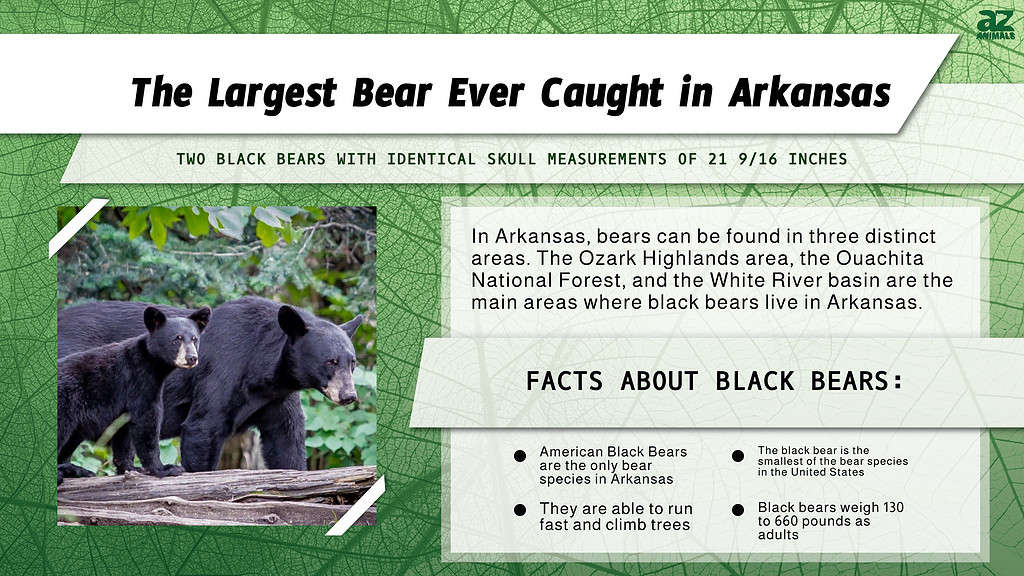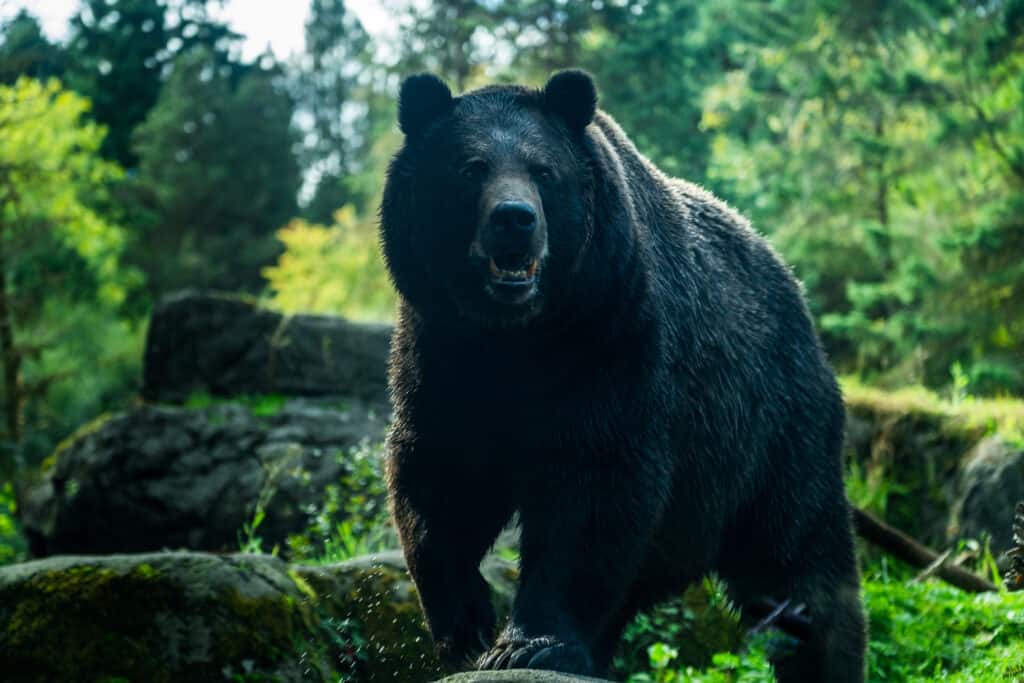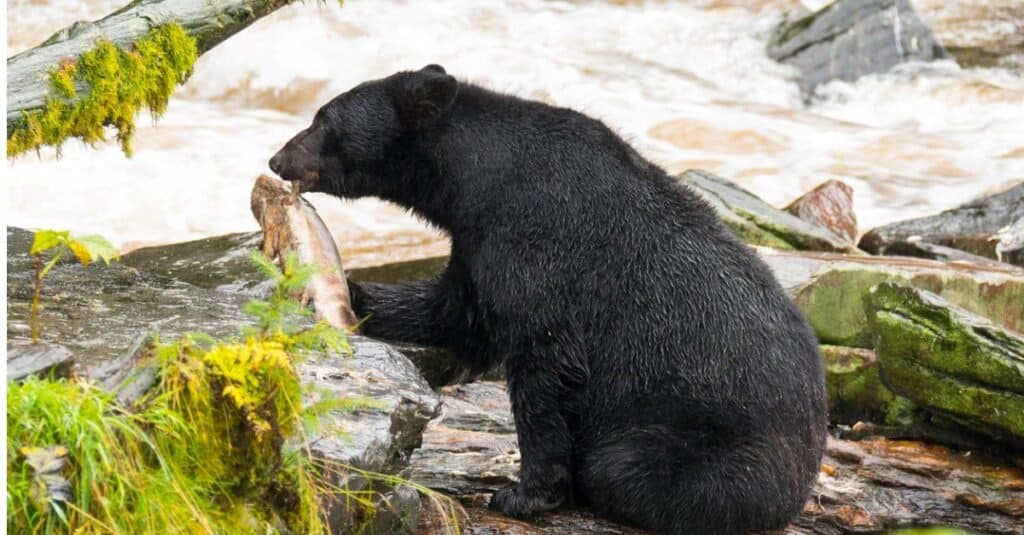It is no wonder that Arkansas is known as “The Natural State” due to its natural beauty. However, did you know that Arkansas was once known as “The Bear State” before that? Arkansas was known as the Bear State during the earliest days of its history. The first time it appeared in print was back in 1858. This is because Arkansas was known for its pretty big black bear population in the early 1800s. However, bear populations have begun to decline since then. Interested in Arkansas bears? Perhaps you want to learn about the largest bear ever caught in Arkansas.
Keep reading to learn more about the bear populations in the state and other interesting facts!
The Largest Bear Ever Caught in Arkansas

The largest black bear caught in Arkansas had a skull measurement of 21 9/16 inches.
©Ghost Bear/Shutterstock.com
According to records kept by Boone and Crockett Club, the largest bear ever caught in Arkansas was actually two black bears with identical skull measurements of 21 9/16 inches. In 2005, hunter Jacob A. Bettendorf caught the first black bear, and in 2018, hunter John J. Baxter caught the second black bear. Boone and Crockett Club, one of North America’s oldest wildlife conservation organizations, recorded all these encounters. Boone and Crockett Club was founded in 1887 by Theodore Roosevelt and George Bird Grinnell as a hunting conservation organization.

Bears in Arkansas: Type and Appearance
Arkansas is home to the American black bear (Ursus americanus). This is the only bear species that lives in the state. The black bear is the smallest of the bear species in the United States. Throughout North America, they are also the most common bear species. Their ability to run fast and climb trees makes them excellent tree climbers. They usually live alone and in heavily wooded areas. While black bears are known for their black coats, they can actually come in a variety of colors from browns to grays to cinnamons to blacks. Even if you see a brown bear in Arkansas, it still counts as a black bear.
Bears in this medium-sized group are usually black with brown muzzles, do not have shoulder humps, and often have white patches on their chests. Black bears weigh 130 to 660 pounds as adults and measure between 50 and 75 inches long. Generally, females measure between 50 and 75 inches and weigh between 90 and 175 pounds. Food quality plays a significant role in determining the size of black bears. Females are typically smaller than males by about 20 to 60 percent. The weight of a cub at birth ranges from 7 to 11 ounces.
Where Is the Bear Habitat in Arkansas?

You will primarily find black bears in the national forests of Arkansas and the highlands area.
©elena_prosvirova/Shutterstock.com
Where are some places in Arkansas where you might be able to find these fascinating creatures? In Arkansas, bears can be found in three distinct areas. The Ozark Highlands area, the Ouachita National Forest, and the White River basin are the main areas where black bears live in Arkansas. Among their favorite foods are acorns, hickory nuts, and berries, which they forage for in the Ozark Highlands and the Ouachita Mountains, and National Forest. Known to be isolated and cut off from other bear populations in the state, the White River Basin population of bears is considered an isolated population.
How Many Black Bears Are There in Arkansas?
Bear populations in the state are estimated at about 4,000 bears. As a matter of fact, the number is increasing. However, this is a stark decline in numbers, considering this state was once called “The Bear State.” What became of the bear population in Arkansas? Also, how many bears inhabited this state in the past?
What Happened to All of These Bears in Arkansas?

Arkansas once had a bear population of nearly 50,000 black bears.
©iStock.com/ElliotHurwitt
In the past, Arkansas had so many bears that the state had the unofficial nickname “The Bear State”. It is estimated that there might have been as many as 50,000 black bears in the state back in the day! In Arkansas, bears played a significant role in the economy. Their meat, fat, and hides were sought after for their high value and high profitability. Oil or fat from bears was particularly prized. It was used for oil lamps and bug repellent. There was even a hair gel made from it!
In addition, settlers started clearing the land so they could plant crops. As forested habitats disappeared, bear populations continued to decline. Due to overhunting and habitat loss, bear numbers declined quickly. By the 1930s, it is estimated that there may have only been 50-100 bears left in the entire state of Arkansas. The animals that once played such an integral role in the ecosystem and economy of the state were now almost extinct.
For the sake of Arkansas black bears, the Arkansas Game and Fish Commission decided to step in and intervene. Over 250 black bears were imported by the AGFC in the late 1950s and early 1960s. There was an official ban on bear hunting in 1927 that lasted until 1980. One of the most successful reintroductions of a large carnivore has been that of black bears in the state.
Is It Legal to Hunt Bears in Arkansas?
Throughout the state, there are seven hunting zones with specific times for bear hunting within each zone, which is closely monitored by the Arkansas Game and Fish Commission. Currently, the AGFC allows about ten percent of the bear population to be hunted each year in order to stabilize and maintain a healthy bear population within the region. Beginning in December 2022, for the first time in modern times, black bear hunters in Arkansas will have access to a legal hunting season in the Gulf Coastal Plain and parts of the Delta.
What to Do if You Come Across a Black Bear in the Wild
It is always a good idea to keep food out of reach of bears and away from tent sites when hiking, hunting, and camping in the Ozarks, Ouachitas, or White River Basin. It is advisable for hikers to travel in groups of two or more when hiking and to make noise in order to deter bears. Singing down the trail is a great way to let bears know you’re coming down the trail and also a great way to have a little fun at the same time. In spite of the fact that bear attacks on people are extremely rare, it is always important to remain vigilant when you are in a bear habitat.
There is nothing more important than ensuring that a black bear has a clear escape route if you do happen to encounter one in the wild. You should stand still if you see a bear before it sees you. Once you have seen the bear, slowly move away from it in the opposite direction. Do not run away from a bear if it has seen you, if it has seen you, back away slowly from the bear. It is also possible to carry bear spray, but you should be aware that bear spray will not be of any use unless the bear is relatively close to you.
If You See a Bear in a Residential Area or Community, What Should You Do?
Over the last few years, bear encounters have become more common in communities around Arkansas. It usually happens in the spring and involves cubs. In many cases, the cubs get lost and end up close to a house after wandering from their mothers. Be cautious if you encounter a bear in a residential area. Never approach a bear, even a cub. Please contact Arkansas Game and Fish Commission so that they can determine if the bear needs to be removed or if it will just return to the forest on its own.
Up Next:
- Discover the Largest Bear Ever Caught in Oregon
- 5 Massive Bears Larger Than a Grizzly
- Discover the Largest Bear Ever Caught in Michigan
- The Largest Black Bear in History
- Discover the Largest Grizzly Bear Ever!
The photo featured at the top of this post is © SCStock/Shutterstock.com
Thank you for reading! Have some feedback for us? Contact the AZ Animals editorial team.






